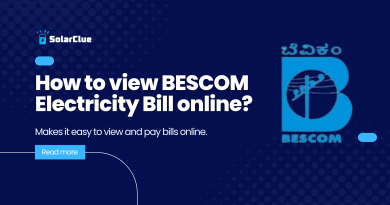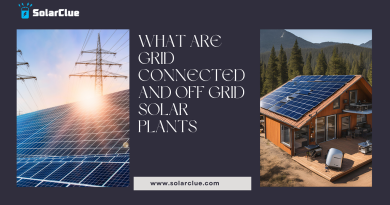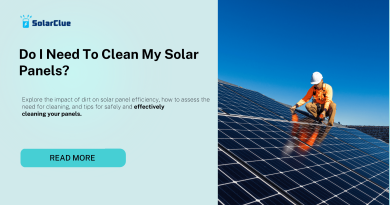What are Solar On-Grid Systems and how to install it?
Homeowners looking to lower their energy bills and lessen their carbon footprint are increasingly choosing solar energy. Of all the options available, on-grid solar systems have drawn the most attention due to their effective and efficient solar power harvesting capabilities. We will explore the definition of Solar On-Grid System Installation in this blog and provide you a detailed installation guide so you can use solar energy as a sustainable source of energy for your house.
Solar On-Grid System Installation: Understanding On-Grid Solar Systems
Grid-tied or grid-interactive systems, another name for on-grid solar systems, are made to function in tandem with the utility grid. This implies that during the day, the electricity your solar panels produce is fed back into the grid, allowing you to draw electricity from it when your panels aren’t producing enough.
The Benefits of On-Grid Solar Systems
Compared to other kinds of solar energy installations, on-grid solar systems have a number of advantages. First off, homeowners can benefit from net metering programmes by being able to feed excess power back into the grid. By giving homeowners credit for the extra electricity they generate, these programmes effectively lower or even completely eliminate their monthly utility bills. Furthermore, because they can rely on the grid for electricity storage, on-grid systems use less batteries than off-grid setups, making them more affordable.
Calculating Your Power Needs
It’s crucial to determine your power requirements before putting in an on-grid solar system. To choose the ideal size for your solar panel system, take into account your monthly energy consumption on average. Divide the total number of kilowatt-hours you use each month by the average number of hours of sunshine in your location to arrive at this figure. It is advised that you speak with an expert in solar energy to make sure your calculations are accurate.
Choosing the Right Location and Panels
For maximum energy production, where your solar panels are installed is essential. Installing the panels in a spot that gets the most sunlight exposure during the day—a south-facing roof or an open space in your yard—is the ideal setup. In order to optimise the panels’ efficiency, take into account the angle at which they are installed. To find the ideal location and angle for your unique situation, it is advised that you speak with a solar expert.
When choosing solar panels, take durability and efficiency into account. For the same surface area, high-efficiency panels will produce more electricity, and durable panels will last longer and function better in a variety of weather situations. To guarantee their quality and performance, look for panels that are certified and adhere to industry standards.
Working with a Professional Installer
An on-grid solar system’s installation is a difficult process that calls for technical know-how. Working with a professional installer is highly recommended as they can evaluate your site, suggest the appropriate equipment, and guarantee a safe and effective installation. Inverters, which change the direct current (DC) electricity generated by the panels into alternating current (AC) electricity used in homes, are among the crucial parts they will also take care of.
System Connection and Permits
After Solar On-Grid System Installation, a qualified installer will connect the system to the utility grid. This involves installing a bidirectional meter that measures both the electricity supplied to and consumed from the grid. Before proceeding with the connection, it is crucial to check with local authorities and obtain any required permits, as some locations may have specific regulatory requirements.
Maintenance and Monitoring
To maximize performance and ensure longevity, regularly monitor and maintain your off-grid solar system. We recommend checking the panels for any dirt or debris that may block the sun’s light and cleaning them as necessary. Furthermore, by keeping an eye on the hardware or monitoring software of the system, you can quickly identify any problems or irregularities.
Conclusion
Join the sustainable energy revolution with SolarClue®, your one-stop solution for all your solar needs. On-grid solar systems present an excellent opportunity for homeowners to save money while capturing clean, renewable energy. Be a proactive part of the green energy movement by acquainting yourself with the fundamentals of on-grid systems through our comprehensive guide.
To ensure a successful on-grid solar system installation, seek expert advice, accurately assess your power requirements, select the right equipment, and commit to regular system maintenance. SolarClue® is here to guide you through this process, providing the expertise and support you need to make your transition to solar energy seamless and efficient.
Lower your carbon footprint and reap the benefits of solar energy for years to come with a thoughtfully planned and expertly installed on-grid solar system. Take the first step towards a sustainable future—embrace clean, renewable energy with SolarClue® as your trusted partner in solar solutions.
Frequently Asked Questions
A solar on-grid system is a solar power setup connected to the electrical grid, allowing for the exchange of energy between the solar panels and the grid.
It works by generating electricity from sunlight, converting it to usable power, and feeding excess energy back into the grid for credits or future use.
On-grid systems offer cost savings, grid stability, and potential income through excess energy production.
They are most effective in areas with reliable grid connectivity, making them ideal for urban and suburban settings.
Installation involves mounting solar panels on the roof, connecting them to inverters, and integrating the system with the electrical grid.
Regular cleaning of solar panels, checking connections, and monitoring system performance are typical maintenance tasks.
No, on-grid systems automatically shut down during power outages for safety reasons. This prevents backfeeding electricity into the grid.
Many regions offer incentives, tax credits, or rebates to encourage the installation of on-grid solar systems.
On-grid solar panels can last 25 years or more, with a gradual decline in efficiency over time.
Yes, on-grid systems are often scalable, allowing you to add more solar panels to increase your energy production capacity.



